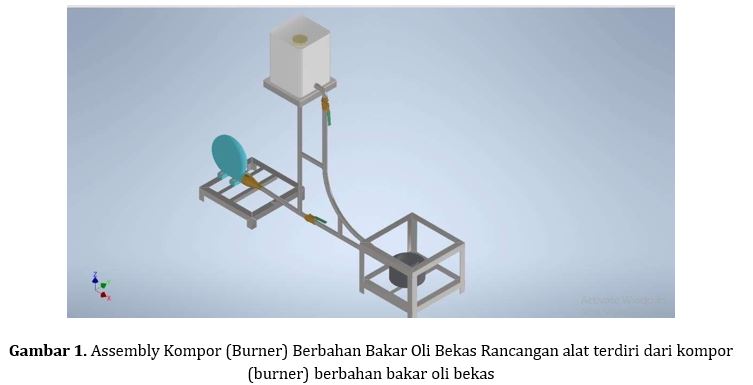KOMPOR EKONOMIS BERBAHAN BAKAR OLI BEKAS
Abstract
This study aims to determine the design of a stove (burner) fueled by used oil, along with its specifications and to find out the test results using a stove (burner) burning used oil. Departing from the lack of utilization of used oil waste and the absence of good tools to utilize used oil. On the other hand, when used as fuel, used oil does not produce complete combustion. This study uses the French design model. This study concluded that the designed stove (burner) has a large shape compared to the burner in general. The stove (burner) reaches a pressure of 3.5 bar with a temperature of 1127 °C. The flames produced by used oil are orange. Comparison of fuel results in data that LPG is 16 minutes faster than used oil in aluminum smelting. The highest flame length is 1.57 m at a variation of 3 bar air pressure and the lowest is 0.83 m at a pressure of 1 bar. There is an influence of pressure variations on the combustion temperature with a minimum and maximum temperature reaching the highest point with a pressure of 2.5 bar with a temperature of 118 °C and 994 °C while the lowest point is at a minimum and maximum temperature at a pressure of 1 bar with a temperature of 80.4 ° C and 662 °C at 0.5 bar pressure. Fuel consumption time with a distance variation of 2200 km produces a fairly short time of 12 minutes 25 seconds. While the consumption time obtained from the variation of the distance of 1800 km is 17 minutes 11 seconds.
References
Badan Pusat Statistik. 2019. Laporan jumlah kendaraan bermotor. Juli. Jawa Tengah: BPS Jawa Tengah.
Dahlan, M.H., Setiawan, A., dan Rosyada, A. 2014. "Pemisahan Oli Bekas dengan Menggunakan Kolom Filtrasi dan Membran Keramik Berbahan Baku Zeolit dan Lempung". Teknik Kimia, No.1, Vol. 20, hal. 38- 45.
Dewan Energi Nasional. 2019. Outlook Energi Indonesia : 1.
I. D. Widodo, Perencanaan dan Pengembangan Produk. Yogyakarta: UII Press, 2005.
Kusnandi, Andi. DKK. 2020. Pemanfaatan oli bekas sebagai bahan bakar alterative kompor yang ramah lingkungan. Jurnal teknologi pertanian Gorontalo :50.
Mulya, Widya. Penyimpanan limbah bahan berbahaya dan beracun studi kasus pada PT. Serasi Mitra Mobil di Balikpapan. Jurnal Keselamatan, KesehatanKerja dan Lindungan Lingkungan 7(2): 449.
P. P. Irawan , IPM . 2017. Perancangan dan Pengembangan Produk Manufaktur. Yogyakarta: ANDI.
Sinta, “oli bekas”, diakses dari https://sinta.unud.ac.id/uploads/dokumen_dir/4b3e1583f043c935725c0c3c6104401f.pdf
Supatra, I Nyoman. 2017. Daur ulang oli bekas menjadi bahan bakar diesel dengan proses pemurnian menggunakan media asam sulfat dan natrium hidroksida : 1.


